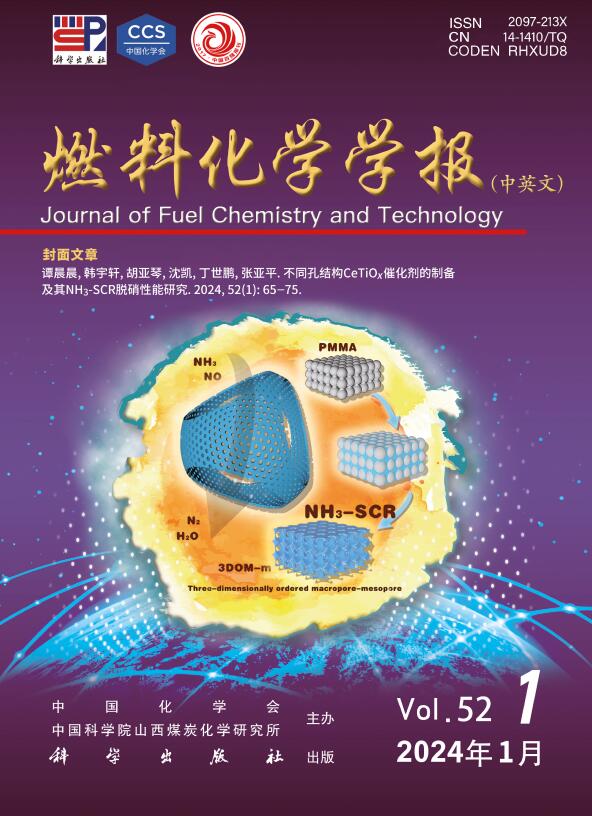Fabrication of SnS2/C3N5 heterojunction photocatalyst for highly efficient hydrogen production and organic pollutant degradation
Q3 Energy
引用次数: 0
Abstract
The semiconductor photocatalysis are considered as one of the most promising candidates in hydrogen energy source and environmental remediation area. In this paper, flower-shaped SnS2 is successfully combined on g-C3N5, and the well matching band structure successfully constitutes a new Type-II heterojunction. As expected, the photocatalytic hydrogen production experiment showed that the quantity of hydrogen produced on 5% SnS2/C3N5 was 922.5 μmol/(g·h), which is 3.6 times higher than that of pure g-C3N5. Meanwhile, in photocatalytic degradation of methylene blue, 5% SnS2/C3N5 composite material can degrade 95% of contaminants within 40 min, showing good photocatalytic degradation performance. The mechanism study indicates that SnS2/C3N5 heterojunction improves the photogenerated charge migration rate and reduces the electron-hole recombination rate, and effectively improves the photocatalytic performance of g-C3N5. This work provides a new idea for designing C3N5-based heterojunctions with efficient hydrogen production and degradation performance.
SnS2/C3N5异质结光催化剂高效制氢和降解有机污染物的制备
半导体光催化被认为是氢能源和环境修复领域最有前途的候选材料之一。在本文中,花状SnS2成功地结合在g-C3N5上,良好匹配的能带结构成功地形成了新的ii型异质结。结果表明,5% SnS2/C3N5光催化制氢量为922.5 μmol/(g·h),是纯g-C3N5的3.6倍。同时,在光催化降解亚甲基蓝中,5% SnS2/C3N5复合材料可在40 min内降解95%的污染物,表现出良好的光催化降解性能。机理研究表明,SnS2/C3N5异质结提高了光生电荷迁移速率,降低了电子-空穴复合速率,有效提高了g-C3N5的光催化性能。这项工作为设计具有高效产氢和降解性能的c3n5基异质结提供了新的思路。
本文章由计算机程序翻译,如有差异,请以英文原文为准。
求助全文
约1分钟内获得全文
求助全文
来源期刊

燃料化学学报
Chemical Engineering-Chemical Engineering (all)
CiteScore
2.80
自引率
0.00%
发文量
5825
期刊介绍:
Journal of Fuel Chemistry and Technology (Ranliao Huaxue Xuebao) is a Chinese Academy of Sciences(CAS) journal started in 1956, sponsored by the Chinese Chemical Society and the Institute of Coal Chemistry, Chinese Academy of Sciences(CAS). The journal is published bimonthly by Science Press in China and widely distributed in about 20 countries. Journal of Fuel Chemistry and Technology publishes reports of both basic and applied research in the chemistry and chemical engineering of many energy sources, including that involved in the nature, processing and utilization of coal, petroleum, oil shale, natural gas, biomass and synfuels, as well as related subjects of increasing interest such as C1 chemistry, pollutions control and new catalytic materials. Types of publications include original research articles, short communications, research notes and reviews. Both domestic and international contributors are welcome. Manuscripts written in Chinese or English will be accepted. Additional English titles, abstracts and key words should be included in Chinese manuscripts. All manuscripts are subject to critical review by the editorial committee, which is composed of about 10 foreign and 50 Chinese experts in fuel science. Journal of Fuel Chemistry and Technology has been a source of primary research work in fuel chemistry as a Chinese core scientific periodical.
 求助内容:
求助内容: 应助结果提醒方式:
应助结果提醒方式:


